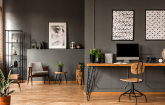The Commercial Office Furniture Market is experiencing steady growth, driven by the rising demand for modern, ergonomic, and sustainable workplace solutions. Increasing adoption of flexible workspaces, co-working trends, and the emphasis on employee well-being are fueling market expansion. Additionally, rapid urbanization, corporate investments in office infrastructure, and the integration of smart furniture with technology are boosting demand. Growing awareness of sustainable materials and eco-friendly designs further supports long-term growth opportunities across global markets.
LEWES, Del., Sept. 18, 2025 /PRNewswire/ -- The global Commercial Office Furniture Market was valued at USD 75 billion in 2024 and is projected to reach USD 110 billion by 2033. This growth reflects a CAGR of 5.2% during 2026–2033, highlighting the sector's resilience and adaptability to changing workplace dynamics.
Increasing investments in corporate infrastructure, rising adoption of hybrid work models, and the shift toward ergonomic and sustainable furniture are expected to drive significant demand across key regions worldwide.
Download PDF Brochure: https://www.marketresearchintellect.com/download-sample/?rid=157500
202 - Pages
126 – Tables
37 – Figures
Scope Of The Report
REPORT ATTRIBUTES |
DETAILS |
STUDY PERIOD |
2020-2031 |
BASE YEAR |
2024 |
FORECAST PERIOD |
2026-2033 |
HISTORICAL PERIOD |
2020-2024 |
UNIT |
Value (USD Billion) |
KEY COMPANIES PROFILED |
Steelcase Inc., Herman Miller Inc., Haworth Inc., HNI Corporation, Knoll Inc., Okamura Corporation, Teknion Corporation, Kimball International, Global Furniture Group, Kinnarps AB, KI Furniture, Groupe Lacasse, Kokuyo Co. Ltd., Sedus Stoll AG, Nowy Styl Group, Humanscale Corporation, Vitra International AG, Wilkhahn, Wiesner-Hager, Bene AG, SUNON, VS Furniture, Martela, Ahrend, Andreu World, Quama Furniture, Henglin Chair Industry, UCI Australia, Furniture Group of America, and Fantoni S.p.A. |
SEGMENTS COVERED |
By Type, By Application And By Geography |
CUSTOMIZATION SCOPE |
Free report customization (equivalent to up to 4 analyst working days) with purchase. Addition or alteration to country, regional & segment scope |
Commercial Office Furniture Market Overview
1. Rising Demand for Ergonomic Office Furniture
The Commercial Office Furniture Market is witnessing robust growth, primarily driven by the increasing demand for ergonomic solutions that promote employee health and productivity. With more companies adopting hybrid and remote work models, organizations are redesigning office spaces to accommodate flexible and collaborative work environments. Ergonomic chairs, adjustable desks, and supportive accessories are becoming essential to reduce workplace injuries and enhance comfort. Additionally, growing awareness of occupational health and wellness has encouraged employers to invest in furniture that ensures better posture and long-term well-being. This shift is not only improving employee satisfaction but also reducing absenteeism and boosting efficiency. Manufacturers are responding with innovative designs that combine functionality with aesthetics, making ergonomics a central focus in modern office design. As organizations continue to prioritize employee well-being, the demand for ergonomic office furniture is expected to grow significantly, creating lucrative opportunities for market players across industries.
2. Sustainability and Eco-Friendly Materials Driving Growth
Sustainability has emerged as a key driver in the Commercial Office Furniture Market, with organizations and manufacturers focusing on eco-friendly solutions. Increasing global awareness of climate change and stricter environmental regulations have prompted companies to adopt sustainable practices, from material sourcing to production methods. The use of recycled wood, biodegradable plastics, and low-carbon processes is gaining traction, making green office furniture highly desirable. Businesses are increasingly aligning their corporate social responsibility (CSR) goals with environmentally conscious procurement, creating demand for furniture that reduces ecological footprints. In addition, customers are prioritizing durability and reusability, minimizing waste generation from frequent replacements. Certifications such as FSC (Forest Stewardship Council) and LEED (Leadership in Energy and Environmental Design) are further encouraging adoption of sustainable office furniture. As green buildings and eco-friendly offices become mainstream, the emphasis on sustainability is expected to significantly shape the future of the global Commercial Office Furniture Market.
3. Technological Integration Enhancing Smart Office Spaces
The integration of technology in furniture is reshaping the Commercial Office Furniture Market by creating smart and connected workplaces. With the rise of digital transformation and the Internet of Things (IoT), office furniture is being designed with embedded features such as wireless charging, USB ports, sensors for posture correction, and connectivity solutions for collaborative work. Smart desks and meeting tables that support productivity tools are gaining popularity in modern offices. These innovations are helping businesses optimize workspace usage and enhance employee performance. In addition, data-driven furniture solutions that monitor usage patterns provide insights into office efficiency, enabling companies to redesign spaces effectively. The growing adoption of hybrid work models has also accelerated the demand for furniture that supports seamless collaboration between in-office and remote employees. As technology becomes deeply embedded in workplace ecosystems, the Commercial Office Furniture Market will continue to expand with smarter, more innovative solutions.
4. Hybrid Work Models Influencing Office Furniture Demand
The adoption of hybrid and flexible work models is transforming demand patterns in the Commercial Office Furniture Market. With organizations allowing employees to split time between home and office, furniture solutions that support flexibility and multifunctionality have become critical. Office spaces are being redesigned into collaborative hubs rather than traditional desk-centered setups. This has led to increased demand for modular furniture, movable partitions, and multipurpose desks that accommodate dynamic workflows. Employees working from home are also investing in compact, ergonomic office furniture to create efficient home workstations. As a result, manufacturers are offering product lines tailored for both corporate and residential office setups. Furthermore, companies are emphasizing furniture that enhances collaboration, creativity, and team interaction when employees are on-site. This evolving trend highlights how the hybrid workplace culture is not only redefining office layouts but also opening new revenue streams for the global Commercial Office Furniture Market.
Download Sample Report Now: https://www.marketresearchintellect.com/download-sample/?rid=157500
5. Regional Market Expansion and Urbanization Trends
Rapid urbanization and economic growth across developing regions are fueling demand in the Commercial Office Furniture Market. Emerging economies in Asia-Pacific, the Middle East, and Africa are experiencing a surge in corporate establishments, IT hubs, and co-working spaces, driving large-scale furniture adoption. Governments are also investing heavily in infrastructure development, creating favorable conditions for new office setups. Urban professionals are increasingly seeking well-designed, modern workplaces that align with global standards, encouraging businesses to invest in high-quality furniture solutions. North America and Europe continue to dominate the market due to established corporate sectors and strong adoption of sustainable practices. However, Asia-Pacific is expected to emerge as the fastest-growing region, supported by rising investments from multinational companies and booming urban workforce populations. As urbanization accelerates and regional markets expand, opportunities for global and local furniture manufacturers are multiplying, ensuring steady growth in the commercial furniture industry worldwide.
6. Competitive Landscape and Market Fragmentation
The Commercial Office Furniture Market is highly competitive, with numerous global, regional, and local players competing to capture market share. Established brands are leveraging strong distribution networks, product innovation, and sustainability certifications to maintain dominance, while emerging players are targeting niche markets with cost-effective and customizable solutions. The rise of e-commerce has also reshaped competition by allowing smaller brands to reach wider audiences directly. Collaborations, mergers, and acquisitions are becoming common strategies to strengthen market presence and expand portfolios. Additionally, manufacturers are increasingly investing in research and development to launch smart, ergonomic, and eco-friendly products that align with evolving customer preferences. Despite fragmentation, the growing demand ensures opportunities for all tiers of players. However, companies that successfully balance cost, innovation, and sustainability are likely to emerge as leaders. This dynamic competitive environment continues to drive innovation and expansion across the global Commercial Office Furniture Market.
7. Impact of Co-Working Spaces and Start-Ups
The growth of co-working spaces and the start-up ecosystem has significantly boosted demand in the Commercial Office Furniture Market. Unlike traditional offices, co-working environments require flexible, stylish, and multifunctional furniture that can adapt to different users and work styles. Start-ups, driven by cost efficiency and creative culture, often prioritize modular and collaborative furniture solutions. The rising popularity of shared workspaces in urban centers is further accelerating this demand, as companies look for quick and affordable furniture setups that maximize space utility. Furthermore, co-working spaces often seek designs that foster networking, creativity, and community building, leading to higher demand for innovative layouts, lounge seating, and collaborative desks. As start-ups continue to play a major role in global economic growth, the need for affordable yet high-quality office furniture is expected to increase. This trend is creating new growth avenues, particularly for manufacturers offering customization and flexible solutions.
8. Future Outlook and Growth Opportunities
The future of the Commercial Office Furniture Market looks promising, driven by evolving workplace trends, sustainability initiatives, and technological advancements. The market is projected to grow from USD 75 billion in 2024 to USD 110 billion by 2033, reflecting a CAGR of 5.2% during 2026–2033. Companies are expected to invest heavily in ergonomic, smart, and eco-friendly furniture that aligns with employee well-being and corporate sustainability goals. Hybrid work models, the rise of co-working spaces, and expanding corporate infrastructure in emerging markets will continue to fuel demand. Additionally, digital integration and data-driven furniture solutions are anticipated to revolutionize workspace management, making offices more efficient and collaborative. Manufacturers who embrace innovation, customization, and sustainable practices will be well-positioned to capture new opportunities. As businesses globally reimagine the future of work, the Commercial Office Furniture Market is set for long-term, steady expansion across all regions.
Geographic Dominance:
North America currently dominates the Commercial Office Furniture Market, supported by a well-established corporate sector, strong adoption of ergonomic designs, and increasing emphasis on sustainability and smart office solutions. The region benefits from high investments in modern workplace infrastructure, alongside growing demand for eco-friendly and technologically integrated furniture. Europe follows closely, driven by green initiatives, strict environmental regulations, and widespread adoption of flexible workplace models. Meanwhile, Asia-Pacific is emerging as the fastest-growing market due to rapid urbanization, rising corporate expansions, and the proliferation of co-working spaces in countries such as China, India, and Japan. Government initiatives promoting commercial infrastructure development further fuel regional demand. Latin America and the Middle East & Africa are also showing steady growth, with increasing multinational company presence and improving office culture. Overall, while North America and Europe maintain leadership, Asia-Pacific is expected to significantly narrow the gap in the coming years.
Commercial Office Furniture Market Key Players Shaping the Future
The Commercial Office Furniture Market is shaped by the presence of leading global and regional players who are driving innovation, sustainability, and technological integration. Key companies include Steelcase Inc., Herman Miller Inc., Haworth Inc., HNI Corporation, Knoll Inc., Okamura Corporation, Teknion Corporation, Kimball International, Global Furniture Group, Kinnarps AB, KI Furniture, Groupe Lacasse, Kokuyo Co. Ltd., Sedus Stoll AG, Nowy Styl Group, Humanscale Corporation, Vitra International AG, Wilkhahn, Wiesner-Hager, Bene AG, SUNON, VS Furniture, Martela, Ahrend, Andreu World, Quama Furniture, Henglin Chair Industry, UCI Australia, Furniture Group of America, and Fantoni S.p.A.
These players are actively focusing on ergonomic designs, eco-friendly materials, and smart furniture integration to meet evolving workplace demands, ensuring the market remains competitive and dynamic.
Commercial Office Furniture Market Segment Analysis
The Commercial Office Furniture Market is segmented based on By Type, By Application, and Geography, providing a comprehensive framework for industry analysis:
1. By Type
- Seating Furniture – Includes ergonomic chairs, executive chairs, task chairs, sofas, and lounge seating designed for comfort, flexibility, and employee well-being.
- Desks & Tables – Executive desks, height-adjustable desks, conference tables, and modular workstations supporting collaborative and hybrid work models.
- Storage Units – Filing cabinets, pedestals, lockers, and shelves designed for space optimization and organization in modern offices.
- Partitions & Panels – Modular partitions, acoustic panels, and movable walls catering to open-office layouts and collaborative environments.
- Other Furniture – Includes reception desks, breakroom furniture, and smart furniture integrated with charging ports and connectivity solutions.
2. By Application
- Corporate Offices – Largest segment, driven by demand for ergonomic and sustainable furniture to enhance productivity and well-being.
- Co-Working Spaces – Fast-growing segment requiring modular, flexible, and stylish furniture solutions for shared work environments.
- Government & Public Offices – Demand driven by large-scale procurement of standardized furniture for administrative facilities.
- Healthcare & Education Institutions – Adoption of ergonomic and durable furniture supporting work efficiency in non-corporate office settings.
- Home Offices – Rising due to hybrid and remote work culture, driving demand for compact, multifunctional, and ergonomic setups.
3. By Geography
- North America – Market leader with strong demand for ergonomic, sustainable, and smart office furniture.
- Europe – Growth supported by eco-friendly initiatives, strict sustainability standards, and modern workplace culture.
- Asia-Pacific – Fastest-growing region, fueled by rapid urbanization, co-working spaces, and corporate expansions in China, India, and Japan.
- Latin America – Steady growth driven by increasing adoption of modern office environments and urban workforce expansion.
- Middle East & Africa – Growth supported by infrastructure development, government projects, and rising demand for corporate spaces.
Consumer Goods & Retail
The Consumer Goods & Retail perspective plays a vital role in shaping the growth of the Commercial Office Furniture Market. With increasing investments in retail expansion and consumer-focused office spaces, demand for stylish, ergonomic, and functional furniture is on the rise. Retailers are adopting innovative office setups to enhance employee productivity and customer experience, driving sales of modular and sustainable designs. Furthermore, growing e-commerce penetration has made office furniture more accessible, enabling direct-to-consumer channels and customizable offerings. As hybrid work models gain traction, both consumer goods companies and retail offices are prioritizing compact, multifunctional, and eco-friendly furniture to optimize space and align with sustainability goals. This trend is expected to strengthen the linkage between retail modernization and the global Commercial Office Furniture Market, fueling steady growth.
Our related Reports
Office Desks Chairs Market is categorized based on Type (Ergonomic Chairs and Desks, Modular Desks, Executive Desks and Chairs, Adjustable and Smart Desks) and Application (Corporate Offices, IT & Technology Firms, Educational Institutions, Government and Public Sector) and geographical regions
Neutron Absorber Material Market is categorized based on Application (Framatome, Mirion Technologies, Holtec International, Mitsubishi Heavy Industries, Westinghouse Electric Company, Areva Inc., Hitachi Zosen Corporation) and Product (Boron‑Stainless Steel Alloy, Boron‑Aluminum Alloy, Boron Carbide‑Aluminum Composites, Gadolinium, Silver‑Indium‑Cadmium, Hafnium) and geographical regions
Negative Pressure Wound Therapy Dressing Kits Market is categorized based on Application (Chronic Wounds, Surgical Wounds, Traumatic Wounds, Burns, Skin Grafts and Flaps, Orthopedic Wounds) and Product (Standard NPWT Kits, Portable NPWT Kits, Single-use NPWT Kits, Canister-based NPWT Kits, Canister-free NPWT Kits, Instillation NPWT Kits) and geographical regions
Multi-joint Robotic Arm Market is categorized based on Application (Automotive Manufacturing, Electronics and Semiconductor Production, Healthcare and Medical Robotics, Logistics and Warehousing, Food and Beverage Processing) and Product (Articulated Robotic Arms, SCARA (Selective Compliance Assembly Robot Arm), Delta Robotic Arms, Collaborative Robotic Arms (Cobots), Cartesian Robotic Arms) and geographical regions
MMORPG Gaming Market is categorized based on Platform Type (PC, Console, Mobile) and Game Type (Fantasy MMORPG, Sci-Fi MMORPG, Historical MMORPG, Superhero MMORPG, Post-Apocalyptic MMORPG) and Payment Model (Free-to-Play, Subscription-Based, Buy-to-Play, Freemium, Pay-to-Play) and geographical regions
About Us: Market Research Intellect
Welcome to Market Research Intellect, where we lead the way in global research and consulting, proudly serving over 5,000 esteemed clients worldwide. Our mission is to empower your business with cutting-edge analytical research solutions, delivering comprehensive, information-rich studies that are pivotal for strategic growth and critical revenue decisions.
Unmatched Expertise: Our formidable team of 250 highly skilled analysts and subject matter experts (SMEs) is the backbone of our operations. With extensive training in advanced data collection and governance, we delve into over 25,000 high-impact and niche markets. Our experts seamlessly integrate modern data collection techniques, robust research methodologies, and collective industry experience o produce precise, insightful, and actionable research.
Diverse Industry Coverage: We cater to a wide array of industries, ensuring that our insights are both relevant and specialized. Our expertise spans: Energy, Technology, Manufacturing and Construction, Chemicals and Materials, Food and Beverages
Having collaborated with numerous Fortune 2000 companies, we bring unparalleled experience and reliability to meet all your research needs. Our proven track record reflects our commitment to excellence and client satisfaction.
Contact Us:
Mr. Edwyne Fernandes
Market Research Intellect
Call Us on: +1 743 222 5439
Email: sales@marketresearchintellect.com
Web: https://www.marketresearchintellect.com/
Logo: https://mma.prnewswire.com/media/2483702/Market_Research_Intellect_Logo.jpg





Share this article